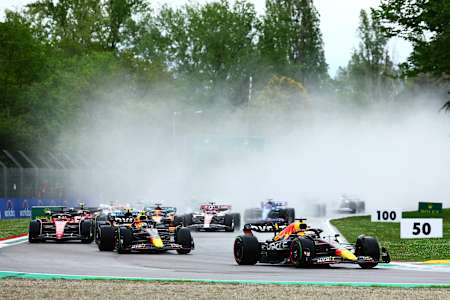Red Bull Motorsports

F1
How does the weather impact F1 teams and drivers?
Rain, heat, humidity, altitude, wind, even snow. Navigating the weather during F1 races is tricky business. Here's what teams like Oracle Red Bull Racing do to ensure they stay ahead of the game.
The 2024 F1 season is the longest on record and will see drivers racing in 24 events held on four continents and in very different conditions. It's vital for the drivers and teams to be ready for any type of weather that may greet them. Let’s take a look at how the weather impacts F1 teams and drivers.
01
Warm and dry
You could say it’s always sunny in Formula One! That’s because an F1 car is designed to go very fast in a straight line and around corners. It does this using the tyres to generate mechanical and aerodynamic grip to channel the power of the engine onto the circuit and push the car forward. A quick look at the calendar underlines that the best conditions to do that is in the warmth of a dry summer. This is why the season starts in the Middle East in March, before it gets too hot, then jets off to Australia, China and Japan, spends the summer in Europe and heads to the Americas in October and November before returning to the Middle East in winter.
The optimal surface for F1, is a smooth, modern Grand Prix circuit like Sakhir, the Circuit of the Americas and Austria's Red Bull Ring. But unusual weather is a big unknown factor – and that’s when things become unpredictable and exciting.
02
Hot and cold
In F1 history, race weekend temperatures have ranged from 5°C to 42.5°C. The rule of thumb is that the hotter the day, the less grip there is on the track. This is because F1 tyres are already heated when put on to the cars and generate more heat as they run on the track, so when a track’s surface is also really hot, it can cause the tyres to overheat and wear out much faster.
F1 cars normally run on slick tyres – smooth tyres that provide the maximum contact with the racing surface – and these need to be brought up to their optimal operating temperature of 100ºC where the rubber softens and connects with the track. The tyre maker Pirelli provides tyres for each race in a variety of soft to hard compounds suited to the surface and anticipated temperature. There are six types of tyre – the hardest C0 to the softest C5 – and all have a limited lifespan, meaning the teams must pit to use up the tyre allocation.
If it is cold, the tyres will last longer but not perform as well or if it is too hot, they deteriorate more quickly, potentially forcing another pit stops. It’s down to the team and driver to figure out which is the best tyre and how to use them, but as a rule of thumb, you’d use a hard tyre in hot weather and on an abrasive track like Bahrain and super softs on a smooth street circuit like Monaco.
03
The wet
Racing in the wet is one of the toughest challenges in F1 and drivers who are quick in the wet are particularly skilled. Max Verstappen was clearly a star, but when he scythed through the pack in torrential rain at Interlagos in 2016, the world sat up and took notice. When it rains, the water prevents the tyres from connecting with the road surface which is where you might see an F1 car aquaplaning off the track.
That's when the drivers will switch to grooved tyres which channel the water away and allow the wheels to grip. There’s two types: the Intermediate tyre, distinguished by the green band on the side, and the Wet, with its blue walls for racing in heavy rain or where there’s standing water.
But grip is only part of the problem. There’s also reduced visibility not only for cars on a clear section of track but for anyone trying to pass in the backwash of spray thrown up by an F1 car. The new ground-effect cars are designed to reduce spray but overtaking in the wet is a massive challenge.
Helmets are fitted with visors that are water-resistant and have a special coating to ensure that rainwater doesn't soak into the helmet. The visors also protect drivers from any optical or facial damage from flying debris.
Max Verstappen throws up a huge wake of spray down Suzuka's main straight
© Getty Images/Red Bull Content Pool
04
Intermittent rain
Biblically heavy rain is a massive challenge, and in extreme circumstances might lead to a race being red-flagged – but occasional rain also poses a test. The difference in performance between wet weather tyres and slicks is massive: a well-timed switch on to the correct tyre can make a massive difference to your finishing position. So when it rains intermittently or even rains on one part of the circuit but not the rest, teams face a tricky challenge to work out whether to take a hit by pitting for new tyres or risk staying out. This is when the strategist will present options but it comes down to the judgement of the team on the pit wall and the driver’s input.
Fast facts… Why does it get hot inside the cockpit of an F1 car?
- The engine is behind the cockpit and generates massive heat.
- The brakes produce heat up to 1,000°C.
- The aerodynamic design of the car actually directs heat into the cockpit.
- There is a lack of airflow inside the cockpit itself.
05
Humidity
Singapore is an outlier for humidity but remains one of the toughest challenges on the F1 calendar. While the cars aren’t particularly bothered by heat and humidity, it takes its toll on the other key component: the drivers. In a typical Singapore Grand Prix drivers lose 3-4kg in body weight – that’s about four litres of sweat.
The temperature inside the cockpit is around 60ºC – which is almost as hot as a sauna and Marina Bay Street Circuit is one of the toughest out there: its 23 corners – the most on the calendar – cascade onto the drivers and the long straight only provides a short amount of breathing space. In short, the Singapore Grand Prix is like boxing for two hours in a sauna perched on a roller coaster.
06
The wind
In F1 history, race weekend temperatures have ranged from 5°C to 42.5°C. The general rule of thumb is that the hotter day, the less grip there is on the track. This is because F1 tyres are already heated when put on to the cars and generate more heat as they run on the track, so when a track’s surface is also really hot, it can cause the tyres to overheat and wear out much faster.
Low visibility from spray and gusting winds make Zandvoort a tough circuit
© Getty Images/Red Bull Content Pool
07
High altitude
Standing 2.2km above sea level, Autódromo Hermanos Rodríguez is the F1 outlier for racing at altitude. In Mexico City, air pressure is about 20 percent lower and air is 25 percent thinner than it is at a sea-level circuit like Miami or Barcelona. That means the drivers are already physically working much harder before they’ve turned a wheel. The engine also has to work harder because it’s getting less oxygen to burn. While modern turbochargers compensate for much of the loss of power, the engine and brakes have less air to cool them, making them operate at higher temperatures.
Heat shimmers: Sainz and Verstappen race in the thin air of Mexico
© Getty Images/Red Bull Content Pool
The teams will open up cooling ducts as much as possible to compensate. Another factor is that because there is less air for the car to push through, the drivers actually enjoy a boost of speed. But the payoff is the mechanical grip is reduced because fewer air particles are moving around the aerodynamic components. In other words, cars are quicker on the straights and slightly slower through the corners. This is why you’ll see cars running the maximum amount of wing to generate as much downforce as possible.
Cool running: Max Verstappen drives an F1 car down the Streif in Austria
© Philip Platzer/Red Bull Content Pool
08
Snow
The coldest race in F1 was the 1978 Canadian Grand Prix where Gilles Villeneuve won his home race in 5ºC, and while there have been hailstorms and sleet at the Red Bull Ring, snow isn’t going to be an issue. But in 2016 Max Verstappen drove an RB7 down the famous Streif run in Kitzbühel, Austria. That car had snow chains on the tyres for grip after Ice speedway-style spikes were found to be ineffective, the floor and suspension raised to their maximum height and the air ducts covered to stop the snow. Even then, the front wing quickly clogged up on the first run out of the garage and the team returned to the garage to refill the antifreeze and coolants and tweak the set-up. In the end, Max and the team produced an astonishing show run that eight years on still amazes.

15 min
Max Verstappen’s F1 show run in the snow
Max Verstappen drives a Formula One car around an iconic ski hill in Austria.






















